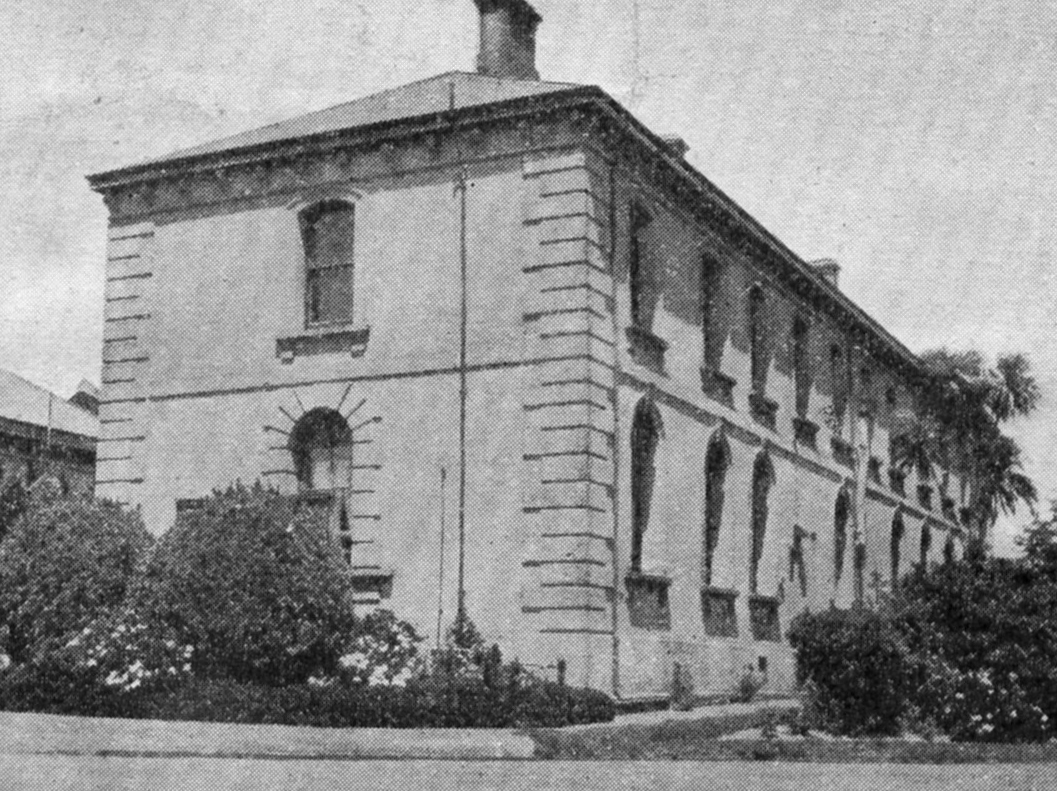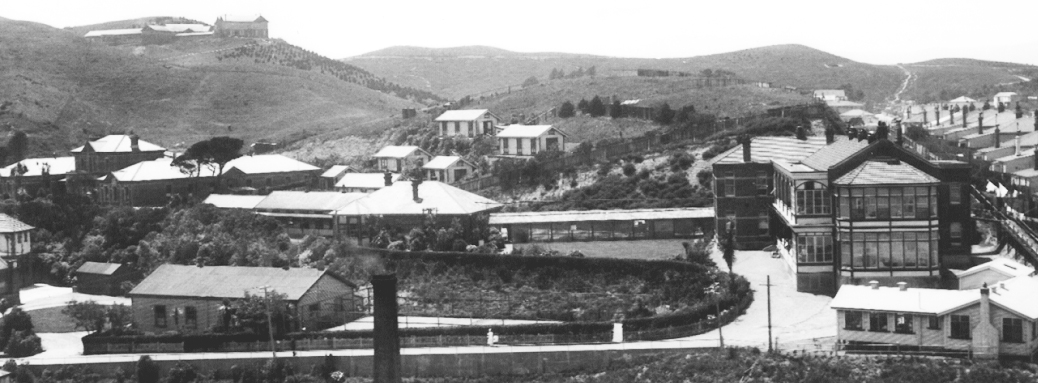
NZ Mail 24 September, 1886
“The proposed new wing for the Wellington Hospital, plans for which have been prepared, will afford much needed accommodation. It will consist of two stories in brick, its position being at the end of the corridor facing Newtown at right angles with and south-west of the present building. The ground floor will be allocated to a children’s ward, 25ft by 23ft, opening into the main passage, with lavatories and bathroom attached; a matron’s room, 16ft by 12ft; a nurses’ dining room, 23ft by 16ft; a lecture and out-patients’ room, 23ft by 16ft; and a surgery and dispensary, 14ft by 11ft. The second story will be set aside for the nurses’ bedrooms, access to which will be gained by a staircase leading from an outside porch in the centre of the wing, and dividing the dining and lecture-rooms.”

The new facility was situated at the western end of the hospital. It was officially opened on Thursday, 28 June, 1888. The cost of construction was around £3,500. Money to furnish the wards had been raised by a Ladies’ Committee, convened by the Mayoress and presided over by Lady Jervois, the Governor’s wife.
NZ Mail 29 June, 1888 (special correspondent)
I paid a special visit to the newly-fitted children’s ward at the Wellington Hospital on Monday last. It was a glorious morning, with a brilliant sun overhead, the air crisp and invigorating; life felt worth living with a sense of perfect health. A brisk walk and the entrance to the Hospital Grounds was reached. A couple of patients sunned themselves on a comfortable seat near the path. A little further on a white and wan youngster was taking an airing in an invalid chair propelled along by one even younger still. As the invalid paused beside the fountain its half-musical, half-monotonous splash seemed to give a cheerful relief from the studied dullness of the patient’s wards. A few steps brought me face to face with the Medical Superintendent, who, when learning the purport of my visit, very kindly offered to act as my personal guide.
The children’s wards – for there are two of them – looked so bright and cheerful in the early morning light that one was tempted to forget that it was a portion of a building devoted to pain and suffering. It brought to my mind my first visit to a boarding school – the rows of cots, methodically correct, except that boarding schools never had half the care bestowed upon them as these wards have. Both wards are the same size, although there is a slight difference in the shape. The one at the far end of the block is the girls’ ward. Six little iron cots, with spring mattresses, snowy white sheets, and cheerful counterpanes, cosy sleep-inviting pillows, upon which are neatly folded a white flannel undergarment and a striped flannel nightgown with turnover collar and cunningly attached wristbands. On the pillows of each cot lay a gaily-dressed doll, which in days to come the tiny sufferers will fondle with infantile maternal care. One special doll on one special cot attracted my attention. It was a doll of more than ordinary fascination. Its rosy cheeks, its wealth of golden hair, its bluest of blue eyes staring so widely at its strange habitation, will be a great contrast to its future owners, whose lack-lustre eyes, pallid lips, and thin wan hands will caress that doll through long days of pain and suffering. This doll had its wooden hands crossed over its lap as it perched in a sitting position, and on that lap was a tiny feeding bottle – a facsimile of one used by living dolls of a bigger growth. I thought of some mother’s love and tenderness who had placed such an attractive present to gladden the eyes of a future patient. At the head of each cot is hung a gay folded fan suspended by a bright coloured ribbon. Round the room here and there were toys that children delighted in – the prancing horse with the improbable spots, the woolley dog with its innocent bark, the tinkling toy dulcimer, the miniature wheel-of-life, the doll’s house, the box of bricks, and last, but not least, the collection of children’s books, easy, amusing and instructive stories, plenty of illustrations, and above all firmly bound. On the walls are hung a goodly array of chromos decked in most gorgeous colours. On a sideboard were vases of many hues, which I hope will be kept plentifully supplied with flowers from those to whom nature is prodigal. The decorations of the ward are in good taste; the walls are of warm neutral tints; the floor has a cheerful covering, with here and there neat cosy-looking semi-Oriental rugs. Each cot has a separate locker by its side where the children’s possessions may be kept to themselves. The boys’ ward is similar in details to the girls’, minus the dolls.
There is one fault with the wards which struck me on my entrance, but that fault is unavoidable now. The block of building is so constructed that the wards have not the advantage of the morning sun shining directly into them. All physicians are aware what an important factor sunlight is in the curing of many diseases……
It is to be regretted, however, that the original designers did not make better provision in this respect. The system of ventilation, too, is not so perfect as it might be. It is no doubt sufficient for the requirements……..
This visit to the children’s ward was one of special pleasure to me. It showed that the Wellington ladies who have so energetically taken the matter into their own hands, have worked with a spirit prompted by true maternal feelings. Throughout each ward there are numerous evidences of woman’s tender care and forethought, recalling the truth of the lines to woman –“When pain and anguish wring the brow, a minist’ring angel thou.”
Despite the opening of two extra adult wards in 1894 (wards 5 and 6), the hospital was increasingly overcrowded with patients and there was an acute shortage of accommodation for nurses and other staff. Proposals by Dr Ewart to deal with this problem impacted on the children’s ward. In 1900 he recommended that the children be moved to one of the ‘Hill Wards’, originally built as temporary structures to the east of the main hospital in 1893 to house patients with typhoid. By 1895, the typhoid epidemic was over and one of the Hill Wards, often referred to as the 'Tin Shed' was used as an out-patient department. This in turn would become the new children’s ward.

The Tin Shed is in the foreground left in this 1932 photo. Behind are the Seddon wards and shelters and to the right, the two-storied Victoria Wards
That move was not popular, nor were there enough beds for the numbers of children admitted in the early 1900s. As an example, during a four month period early in 1905, of fifty eight children under the age of thirteen years admitted for surgery (mainly Ts and As), ten had to be accommodated in adult wards.
In 1905 there was some public agitation for a separate children’s hospital situated away from the main hospital. Kelburn and the Hutt Valley were mooted as possible sites. It was proposed that the children’s hospital be modelled on the one at Grebe in Sydney. However, sufficient support was not forthcoming.
By 1909 the children’s ward was in a bad state of repair and the need for a new children’s hospital on the Newtown site was deemed urgent by the Hospital Trustees. Plans for this venture, initially estimated to cost £7,000, were approved in December 1909.
Nursing Staff
Acknowledgement is due to the nurses who were in charge of the various children's wards above.
[Only some of these have been identified.]
 Kate Beetham (1892 - 1893)
Kate Beetham (1892 - 1893)
 Frances Keith Payne (1894)
Frances Keith Payne (1894)
Jane Todd (1900), Edith Rennell (1902 - 1903), Sister Hazlett (1903), Ellen Watt (1903), Kate Smith (1907), Maisie Richter (1907)
 Evelyn Gertrude Brooke (1907 - 1908)
Evelyn Gertrude Brooke (1907 - 1908)
 Edna Pengelly (1908 - 1909)
Edna Pengelly (1908 - 1909)
Violet Price (1911)
Medical Staff
As regards medical staff, during the period 1886 - 1912, there were children's physicians or surgeons on staff - the medical needs of admitted children were attended to by the Resident Medical Superintendent. Most notable was Dr John Ewart who occupied this role from 1889 - 1909.
 John Ewart
John Ewart
return to top of page